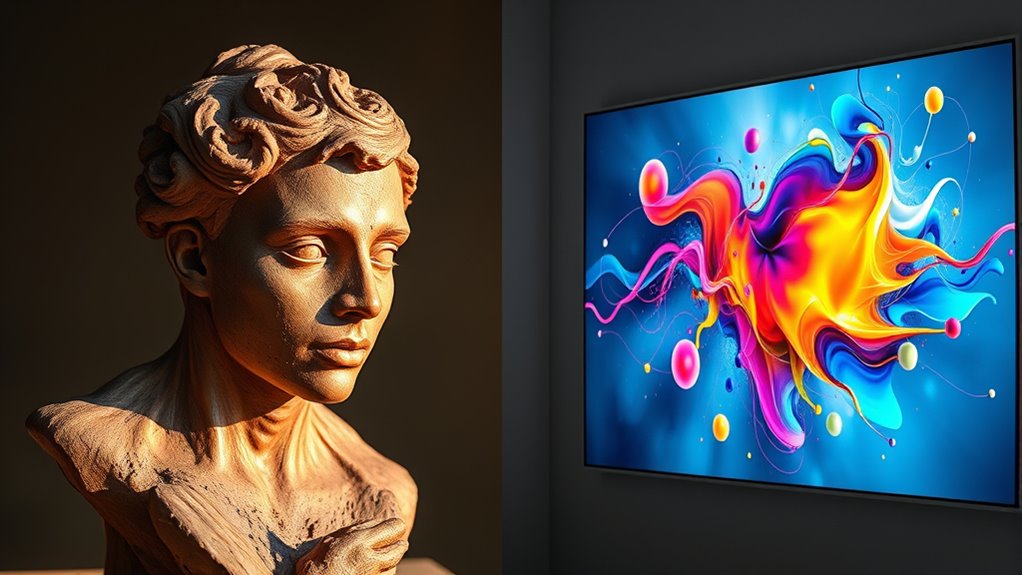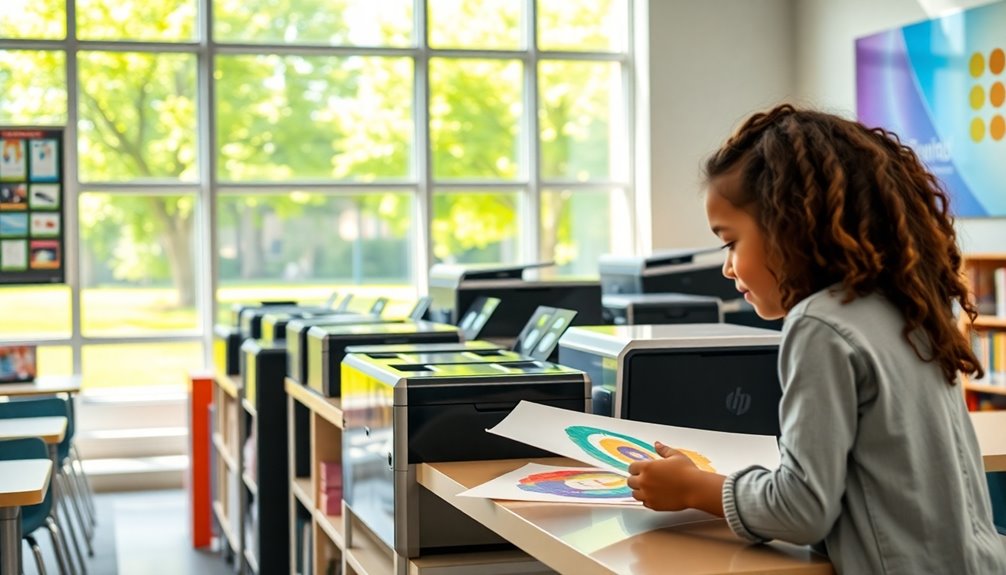Human-made art is driven by personal vision, emotion, and meaningful expression, reflecting the creator’s inner journey and vulnerabilities. AI-generated art, on the other hand, relies on analyzing patterns and data without conscious understanding or feelings, often lacking emotional depth. While both can produce beautiful results, human creations resonate more deeply because of their authentic stories and intentions. To understand what truly makes art meaningful, explore how emotion and experience shape human artistry.
Key Takeaways
- Human art is driven by creative intent and personal vision, while AI-generated art is based on patterns and data processing.
- Human-created art evokes emotional responses through storytelling and vulnerability; AI art often lacks this emotional depth.
- AI produces technically impressive works without conscious understanding or emotional experience, limiting authenticity.
- Emotional resonance in human art reflects genuine human experiences, making it more meaningful and impactful.
- Appreciating the differences enhances recognition of authenticity, inner expression, and the value of human artistry.

Have you ever wondered what truly distinguishes human-made art from AI-generated creations? At its core, the difference often lies in the concept of creative intent and emotional resonance. When you create art with your own hands or mind, you’re driven by a personal vision, a desire to express something meaningful that reflects your thoughts, feelings, or experiences. This intent infuses your work with a unique purpose that algorithms can’t genuinely grasp. AI, on the other hand, generates images or music based on patterns and data it has processed, but it doesn’t possess consciousness or emotions. It mimics creativity without truly understanding what it’s producing. That’s where the emotional resonance of human art comes into play. When you look at a painting or listen to a piece of music crafted by a person, you often feel an inexplicable connection—an emotional response rooted in the artist’s experiences, struggles, or insights. This resonance is not just about the colors or sounds; it’s about the story, the intention behind the work, and the vulnerability it reveals. It’s why human art can evoke feelings of joy, sorrow, hope, or nostalgia in a way that feels authentic and profound.
AI-generated art, while often technically impressive, tends to lack this depth of emotional connection. It can replicate styles, generate beautiful images, or compose melodies, but it doesn’t experience or understand the emotions it’s supposed to evoke. Its creations are the product of complex algorithms, not personal journeys or reflections. As a viewer, you might appreciate the craftsmanship or the innovation behind AI art, but it rarely elicits the same emotional response as human-made art, which carries the imprint of human longing, passion, or doubt. Additionally, the concept of emotional resonance distinguishes human artistry, as it stems from genuine human experiences and vulnerabilities that algorithms cannot replicate. Understanding this distinction helps you appreciate the value of human artistry. It’s not just about the visual or auditory outcome, but the story behind it—the creative intent that fuels it and the emotional resonance it sparks within you. When you engage with human-made art, you’re connecting with another person’s inner world, their hopes and fears, their moments of clarity or confusion. AI art, while intriguing and often beautiful, remains a reflection of human input rather than an extension of human experience. Recognizing this difference enriches your appreciation and deepens your understanding of what makes art truly meaningful.
Frequently Asked Questions
Can AI Art Evoke Genuine Emotional Responses?
Yes, AI art can evoke genuine emotional responses. While some might question its emotional authenticity, viewers often connect deeply with the visuals and themes. Your emotional response depends on how the art resonates with you, creating a sense of emotional authenticity. AI-generated pieces can foster a strong viewer connection, making you feel understood or moved, regardless of the creator’s identity. It’s about the impact the art has on your feelings.
How Do Artists Feel About AI Replacing Traditional Methods?
Imagine a river carving its own path—artists feel mixed, like currents colliding. Some see AI as a threat to their creative independence and artistic authenticity, fearing it’s a tide that could erode traditional skills. Others embrace it, viewing AI as a new brushstroke, expanding possibilities. Ultimately, many hope AI enhances their craft while preserving the soul behind human artistry, not replacing it.
Is AI Art Eligible for Gallery Exhibitions or Awards?
Yes, AI art can be eligible for gallery exhibitions and awards, but it often sparks debates about creative authenticity and artistic ownership. You might find that some curators value the innovative process behind AI-generated works, while others question the artist’s role in the creation. Ultimately, your work’s acceptance depends on how you present your concept of creativity and the originality you claim, regardless of the method used.
What Ethical Concerns Surround Ai-Generated Art?
You should consider that ethical concerns around AI-generated art include copyright concerns, as it’s unclear who owns the rights to the artwork. Additionally, authenticity debates arise since AI art may lack the personal touch and emotional depth of human-made pieces. These issues challenge traditional notions of creativity and originality, prompting questions about transparency and fairness. Addressing these concerns helps guarantee responsible use and recognition of AI-generated work.
Will AI Art Diminish the Value of Human Craftsmanship?
Think of AI art as a river flowing alongside human craftsmanship. It won’t diminish the authenticity or artistic originality you bring; instead, it offers new channels for expression. Your craftsmanship remains unique, rooted in human emotion and intent. AI can complement your work, but it can’t replicate the depth of genuine creativity. The value of your artistry stays strong, as authenticity and craftsmanship continue to define true artistic worth.
Conclusion
Ultimately, whether you prefer human-made or AI-generated art, remember that each is a different brushstroke on the same canvas of creativity. Human art carries raw emotion and soul, like a heartbeat in every stroke. AI art, meanwhile, is a tool that pushes boundaries and sparks new ideas. Both are threads in the tapestry of artistic expression—each beautiful in its own way. Embrace the diversity, and let your imagination run wild like a river unbound.










